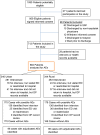Post-Discharge Adverse Events Among Urban and Rural Patients of an Urban Community Hospital: A Prospective Cohort Study
- PMID: 25822112
- PMCID: PMC4510218
- DOI: 10.1007/s11606-015-3260-3
Post-Discharge Adverse Events Among Urban and Rural Patients of an Urban Community Hospital: A Prospective Cohort Study
Abstract
Background: There has been little research to examine post-discharge adverse events (AEs) in rural patients discharged from community hospitals.
Objective: We aimed to determine the rate of post-discharge AEs, classify the types of post-discharge AEs, and identify risk factors for post-discharge AEs in urban and rural patients.
Design: This was a prospective cohort study of patients at risk for post-discharge adverse events from December 2011 through October 2012.
Patients: Six hundred and eighty-four patients who were under the care of hospitalist physicians and were being discharged home, spoke English, and could be contacted after discharge, were admitted to the medical service. Patients were stratified as urban/rural using zip code of residence. Rural patients were oversampled to ensure equal enrollment of urban and rural patients.
Main measures: The main outcome of the study was post-discharge AEs based on structured telephone interviews, health record review, and adjudication by two blinded, trained physicians using a previously established methodology.
Results: Over 28% of 684 patients experienced post-discharge AEs, most of which were either preventable or ameliorable. There was no difference in the incidence of post-discharge AEs in urban versus rural patients (ARR 1.04 95% CI 0.82-1.32 ), but post-discharge AEs were associated with hypertension, type 2 diabetes mellitus, and number of secondary discharge diagnoses only in urban patients.
Conclusions: Post-discharge AEs were common in both urban and rural patients and many were preventable or ameliorable. Potentially different risk factors for AEs in urban versus rural patients suggests the need for further research into the underlying causes. Different interventions may be required in urban versus rural patients to improve patient safety during transitions in care.
Figures
Comment in
-
Capsule Commentary for Tsilimingras et al., Post-Discharge Adverse Events Among Urban and Rural Patients of an Urban Community Hospital: A Prospective Cohort Study.J Gen Intern Med. 2015 Aug;30(8):1190. doi: 10.1007/s11606-015-3385-4. J Gen Intern Med. 2015. PMID: 25952655 Free PMC article. No abstract available.
References
-
- Tsilimingras D, Bates DW. Addressing postdischarge adverse events: a neglected area. Jt Comm J Qual Patient Saf. 2008;34:85–97. - PubMed
Publication types
MeSH terms
Grants and funding
LinkOut - more resources
Full Text Sources
Other Literature Sources
Medical


